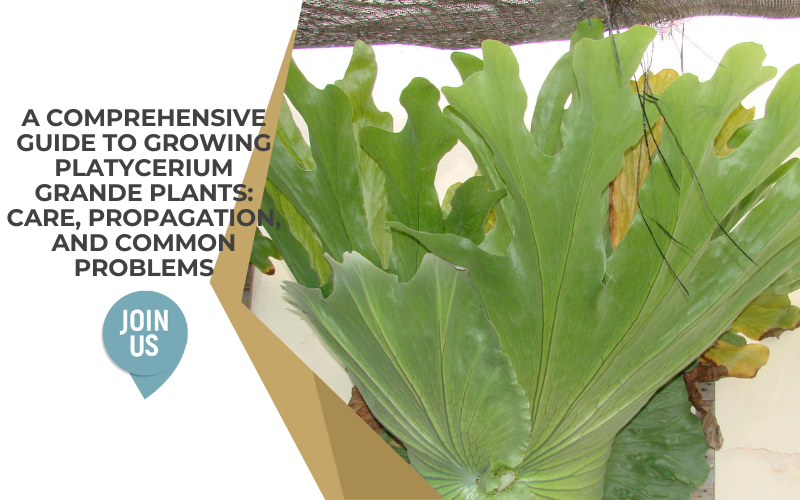+91 9493616161
+91 9493616161

Platycerium grande, commonly known as the giant staghorn fern, is a stunning epiphytic fern that is native to the tropical rainforests of Southeast Asia. This fern is highly valued for its unique and striking fronds, which resemble the antlers of a stag. In this guide, we will provide a comprehensive overview of Platycerium grande, including its origins, ideal growing conditions, care tips, and more.
Platycerium grande is a member of the Platycerium genus, which contains approximately 18 species of ferns. The genus is named for the Greek words "platys" and "keras," which mean "broad horn." The giant staghorn fern is native to the rainforests of Southeast Asia, including Indonesia, Malaysia, and the Philippines.
In its natural habitat, Platycerium grande grows as an epiphyte, which means it grows on other plants or trees. It attaches itself to the bark of trees or rocks using specialized fronds called basal fronds. These fronds are modified into a basal rosette that helps anchor the fern to its host. The fern's fertile fronds, which bear the spores that produce new plants, grow upward and out from the basal rosette, creating the distinctive antler-like shape.
The Platycerium grande fern has two distinct types of fronds: sterile and fertile. The sterile fronds are the larger, more prominent fronds that resemble the antlers of a stag. These fronds can grow up to four feet in length and are covered in a dense layer of fuzzy, gray-green hairs. The fertile fronds, which are smaller and less showy, emerge from the center of the basal rosette and bear the fern's spores.
In addition to its fronds, Platycerium grande has a rhizomatous root system. The roots are thick and fleshy, and they help the fern absorb water and nutrients from its surroundings.
Platycerium grande is a tropical fern that thrives in warm, humid environments. To grow this fern successfully, you will need to provide it with the following growing conditions:
Temperature: Platycerium grande prefers temperatures between 60 and 80 degrees Fahrenheit (15-27 degrees Celsius). It can tolerate cooler temperatures, but it should not be exposed to temperatures below 50 degrees Fahrenheit (10 degrees Celsius).
Humidity: This fern requires high humidity levels to thrive. Aim for humidity levels between 70% and 80%. If your home is particularly dry, you may need to use a humidifier or place a tray of water near the plant to increase humidity levels.
Light: Platycerium grande prefers bright, indirect light. It should not be exposed to direct sunlight, as this can scorch the fronds. A north or east-facing window is an ideal location for this fern.
Soil: This fern is an epiphyte and does not require soil to grow. Instead, it grows on other plants or trees. If you are growing it in a container, you should use a well-draining potting mix that is high in organic matter.
Water: Platycerium grande requires regular watering to keep its roots and fronds hydrated. Water the fern when the top layer of soil feels dry to the touch. Be sure to water the entire plant, including the basal rosette and the fertile fronds.
Fertilizer: You can fertilize Platycerium grande once a month during the growing season (spring and summer). Use a balanced liquid fertilizer, diluted to half-strength.
Platycerium grande can be propagated from spores or by dividing the rhizome. Propagation by spores is a bit more challenging and requires patience, but it can be a rewarding way to increase your collection of these unique ferns. Here's how to propagate Platycerium grande from spores:
Collect the spores: Wait until the fertile fronds turn brown and begin to release their spores. Collect the spores by placing a paper bag over the frond and gently tapping it. The spores will fall into the bag.
Prepare the growing medium: Platycerium grande spores require a sterile growing medium to prevent contamination. You can use a commercial sterile potting mix or make your own by mixing equal parts peat moss and sand.
Sow the spores: Spread the spores over the surface of the growing medium, being careful not to overcrowd them. You can also mix the spores with a bit of water to create a slurry and then spread the mixture over the growing medium.
Cover the container: Place the container in a plastic bag or cover it with plastic wrap to create a humid environment. Keep the container in a warm, bright location, but out of direct sunlight.
Wait for germination: Platycerium grande spores can take anywhere from several weeks to several months to germinate. Be patient and keep the growing medium moist but not waterlogged.
Transplant the seedlings: Once the spores have germinated and the seedlings have grown several fronds, they can be transplanted into individual pots or onto a suitable host plant.
Propagation by division is a simpler method and involves separating the fern's rhizome into smaller sections. Here's how to propagate Platycerium grande by division:
Remove the fern from its pot: Carefully remove the fern from its pot, being careful not to damage the fronds or roots.
Divide the rhizome: Use a sharp, sterile knife to divide the rhizome into smaller sections. Each section should have several fronds and a healthy root system.
Repot the sections: Plant each section in a separate pot, using a well-draining potting mix. Water the newly potted ferns thoroughly.
Care for the new plants: Place the new plants in a bright, humid location and care for them as you would for an established Platycerium grande fern.
Common Problems and Solutions
Platycerium grande is a relatively low-maintenance plant, but it can still experience a few issues. Here are some common problems and solutions:
Platycerium grande is a stunning fern that can add a touch of tropical elegance to any indoor space. With the
Leave a comment